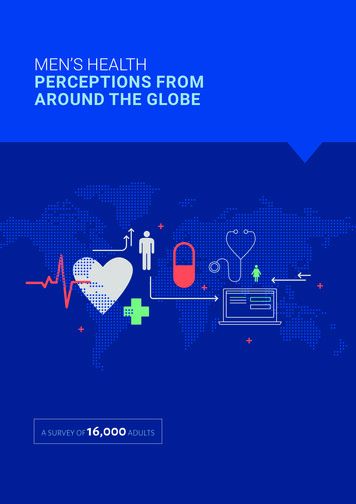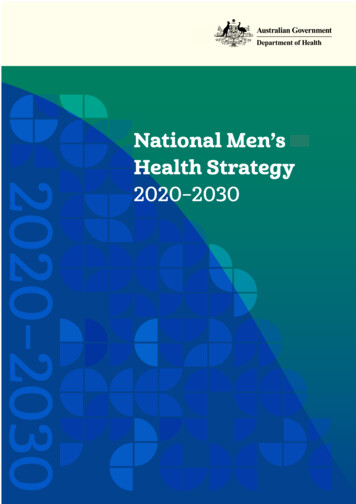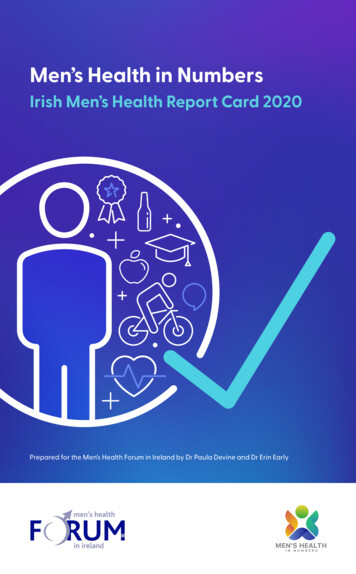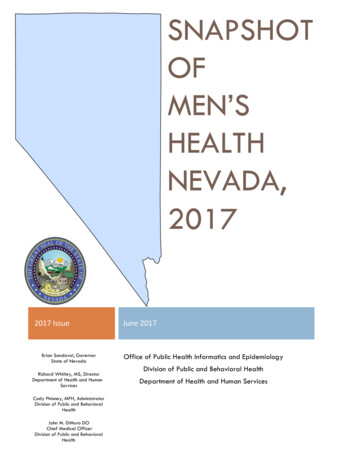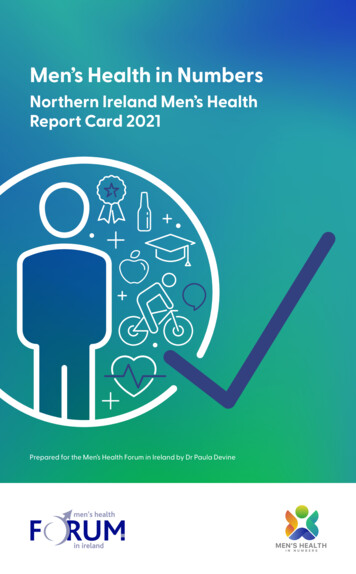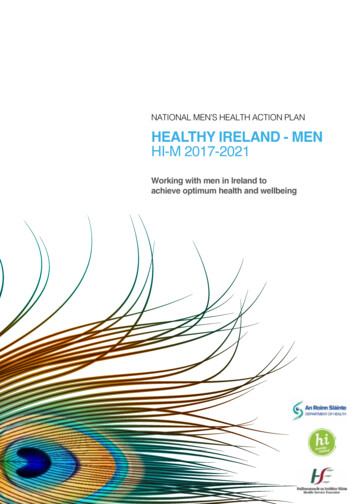
Transcription
National Men’s Health Action PlanHealthy Ireland - MenHI-M 2017-2021Working with men in Ireland toachieve optimum health and wellbeing
ContentsForewordiAbbreviationsiiiExecutive Summary1Part 1: Preamble3Ireland’s pioneering role in men’s health policy development3National Men’s Health Policy Review4The rationale for maintaining a specific focus on men’s health4Evidence supporting gender-specific or ‘men-friendly’ approaches5Building on the momentum and key milestones achieved to date6Part 2: National Men’s Health Action Plan; Healthy Ireland - Men[HI-M] 2017-20219AppendicesCitation: Health Service Executive, 2016Appendix 1: Key NMHPAP milestones in the context of the Healthy Ireland policy framework15Appendix 2: Potential cross-sectoral impact of HI-M 2017-202116Appendix 3: Impetus and background to policy development19Appendix 4: National Men’s Health Policy Review21Appendix 5: The rationale for maintaining a specific focus on men’s health25Appendix 6: National and international publications and presentations29Appendix 7: Membership of the National Men’s Health Policy Implementation Group41Appendix 8: Existing policy that will be supported by actions from HI-M 2017-202143
ForewordIreland was the first country in the world to adopt a National Men’s Health Policy, and other countriesare now building upon the pioneering spirit and practical learning from the Irish experience. Thepublication of this Action Plan for Men’s Health [Healthy Ireland - Men 2017-2021 (HI-M 2017-2021)] isa significant and important step in continuing the momentum and progress that has been achieved inthe area of men’s health policy in Ireland in recent years.There remains an urgent need to maintain a specific focus on men’s health. This is grounded incontinued sex differences in life expectancy and mortality, health inequalities between different subpopulations of men, a substantial body of evidence supporting a gender-specific approach to engagemore effectively with men, and the imperative to build on progress achieved to date. Underpinning thisprogress has been an explicit focus on gender-specific strategies related to community engagement,capacity building, partnership and sustainability.In response to the key recommendations of an independent Review of the previous National Men’sHealth Policy and Action Plan [NMHPAP 2008-2013], HI-M 2017-2021 adopts a focused and strategicapproach to address many of the key health topics and themes under the Framework of Actionshighlighted in Healthy Ireland and the HSE priority areas.The same theoretical and philosophical principles that underpinned the NMHPAP 2008-2013 continueto provide a basis from which to advance men’s health in the context of HI-M 2017-2021. Sincepublication of the NMHPAP 2008-2013, there has been a breadth of evidence supporting and informingthe need for a gender-specific approach across a diverse range of topics, settings and target malepopulation groups. This evidence, along with ongoing men’s health work, provides a platform fromwhich to progress and build momentum in the years ahead.HI-M 2017-2021 is relevant to a wide audience - policy makers, service providers, health and alliedhealth professionals, and to those who work with men in the community and voluntary sectors - andsets out a new vision and roadmap for men’s health that can play a pivotal role in supporting theimplementation of Healthy Ireland.Dr. Cate HartiganHead of Health Promotion and ImprovementHealth and Wellbeing Division, Health Service Executive8i
AbbreviationsCHBRCentre for Health Behaviour Research (in Waterford Institute of Technology)DAFMDepartment of Agriculture, Food and the MarineDoESDepartment of Education and SkillsDoHDepartment of HealthDoJEIDepartment of Jobs, Enterprise and InnovationDoSPDepartment of Social ProtectionE.G.Exempli Gratia (for example)FCSEFamily Communication and Self-EsteemFSPFarm Safety PartnershipGAAGaelic Athletic AssociationGMGender MainstreamingGPGeneral PractitionerHBSCHealth Behaviours in School-aged ChildrenHIHealthy IrelandHI-MHealthy Ireland - MenHSAHealth and Safety AuthorityHSEHealth Service ExecutiveICGPIrish College of General PractitionersICS Irish Cancer SocietyIHFIrish Heart FoundationIMSA Irish Men’s Sheds AssociationIPHInstitute of Public HealthITCInstitute of Technology CarlowLGBTLesbian, Gay, Bisexual and TransgenderLSP Local Sports PartnershipMDNMen’s Development NetworkMHFIMen’s Health Forum in IrelandMHWMen’s Health WeekMoMMen on the MoveNCMHNational Centre for Men’s Health (in the Institute of Technology Carlow)NMHPNational Men’s Health PolicyNMHPAPNational Men’s Health Policy and Action PlanNMHPIGNational Men’s Health Policy Implementation GroupNOSPNational Office for Suicide PreventionNYCINational Youth Council of IrelandPAPhysical ActivityPEPhysical EducationSEGSocio-Economic GroupSI Sport IrelandVISPHESocial, Personal and Health EducationWITWaterford Institute of Technologyiii
Executive SummaryIreland became the first country in the world to publish a National Men’s Health Policy [NMHP] in 2009and has been to the forefront, internationally, in advancing men’s health at a research, policy andadvocacy level. Underpinning its approach to men’s health policy development and implementationhas been an explicit focus on gender-specific strategies related to community engagement, capacitybuilding, partnership and sustainability. Much of the work to date has revolved around excellentpartnerships between the statutory, community/voluntary and academic sectors, resulting in a strongevidence base. Although ostensibly a men’s ‘health’ policy, the Policy has had an explicit focus onmainstreaming men’s health across a broad spectrum of policy areas (within and outside of health) andcontributing to more effective implementation of other policy areas.There remains a strong rationale for maintaining a specific focus on men’s health. This is grounded in:continued sex differences in life expectancy and mortality; health inequalities between different subpopulations of men; a substantial body of evidence supporting a gender-specific approach; and theimperative to build on the momentum and key milestones achieved in men’s health over the past tenyears. The New Public Sector Equality and Human Rights Duty provides a mandate for maintaining apolicy focus on men affected by marginalisation (e.g. Traveller men, ethnic minority men and gay men).In June 2014, the Department of Health [DoH] and the Health Service Executive [HSE] commissioneda Review of the Policy, with a view to informing the future direction of men’s health policy in Irelandaligned to the key themes of Healthy Ireland [HI]. The Review concluded that, overall, the Policy hadmade a significant contribution to advancing men’s health in Ireland and paid tribute to the significantprogress that had been achieved in: (i) promoting an increased focus on men’s health research inIreland; (ii) developing health promotion initiatives that support men to adopt positive health behavioursand to increase control over their lives; (iii) building social capital within communities for men; and(iv) the development and delivery of men’s health training for health and other professionals. TheReview also paid tribute to the significant progress that had been achieved in developing sustainablealliances and partnerships in the area of men’s health involving statutory, community and voluntary,and academic sectors. Notwithstanding what it saw as the ambitious scope and breadth of policyrecommendations, the Review recommended that there should be a continued dedicated nationalfocus on men’s health in Ireland to ensure that the momentum and traction that has been achievedto date is not lost. The Review also recommended the development of a revised and more focusedAction Plan for men’s health that should make explicit links to other health policy areas and clearlydemonstrate how addressing men’s health will support the effective implementation of Healthy Ireland.The same theoretical and philosophical principles that underpinned the previous Action Plan continueto provide a basis from which to maintain this ongoing agreed approach to men’s health policyimplementation and from which to advance men’s health in the future. The revised Men’s Health ActionVIII1
Plan [Healthy Ireland - Men 2017-2021: HI-M 2017-2021] sets out a new vision and roadmap for men’shealth in the years ahead. The Plan works in tandem with existing structures and programmes withinthe HSE and is designed to contribute to more effective implementation of programmes and servicesby mainstreaming men’s health across a broad spectrum of policy areas. Four Themes (T) and twentyeight Actions (A) have been identified under HI-M 2017-2021. These Themes and Actions have beenframed with due regard to the key health topics and themes under the Framework of Actions highlightedin Healthy Ireland and the HSE priority areas.Part 1: PreambleIreland’s pioneering role in men’s health policy developmentIreland has been to the forefront internationally in advancing men’s health at a research, policy andadvocacy level1. As the first country in the world to develop a National Men’s Health Policy and ActionPlan [NMHPAP 2008-2013]2 Ireland’s pioneering role in men’s health policy development has beendescribed by the British Medical Journal as ‘a particular source of inspiration for other countries3.T1: Establish appropriate governance structures that are aligned with Healthy Ireland to overseethe implementation of HI-M 2017-2021.Through its implementation to date, a number of significant milestones have been achieved in thecontext of the Healthy Ireland Policy Framework (see Appendix 1). Crucially, Ireland’s NMHPAP 20082013 has also provided a vision and a framework for action that enabled the field of men’s health toT2: Contribute to the implementation of the priority programmes for Healthy Ireland - healthyeating and active living, wellbeing and mental health, positive ageing, alcohol, tobacco free,and healthy childhood - with a particular emphasis on addressing health inequalities betweendifferent sub-populations of men.T3: Build capacity with those who work with men and boys to adopt a gender competent andmen-friendly approach to engaging men and boys at both an individual and an organisationallevel.develop in synergy with other policy areas within and beyond the health sector4. Underpinning thisapproach has been an explicit focus on gender-specific strategies related to community engagement,capacity building, partnership and sustainability. Much of the work to date has revolved aroundexcellent partnerships between the statutory, community/voluntary and academic sectors, resulting ina strong evidence base. Having a NMHPAP has also resulted in men’s health being more visible andoccupying a more prominent place in public discourse4.The positioning of men’s health in such broad terms within NMHPAP 2008-2013, was a clear statementT4: Ensure that research continues to underpin the development of men’s health practice inIreland and contributes to the Healthy Ireland agenda.of the cross-sectoral and inter-departmental responsibilities associated with promoting men’s health,but also drew attention to the potential gains and benefits to other sectors and government departmentsof working in partnership to support men’s health (see Appendix 2). In the context of the Departmentof Jobs, Enterprise and Innovation, for example, a man’s inability to live a full and productive life is aconsiderable burden to the economy in terms of associated healthcare costs and loss of workplaceproductivity. Increasing the uptake of parental leave by fathers is crucial in terms of a broader genderrelations approach to equality in the workplace, and to childcare and domestic labour within the home(Department of Jobs, Enterprise and Innovation). The Department of Education and Skills has a criticalrole to play in nurturing boys’ self-esteem and communication skills from an early age, to enable themas adults to have acquired a language for expressing emotional distress and to be more open aboutseeking help, particularly for emotional problems. Notwithstanding the challenges associated withinter-departmental work5, continued efforts are needed to promote men’s health in the future throughsynergies with other government departments. A more detailed overview of the impetus and mandatefor developing a NMHPAP is outlined in Appendix 3.Richardson N. & Carroll P. (2009). Getting men’s health onto a policy agenda - charting the development of a national men’s health policy in Ireland. Journal of Men’sHealth: Vol 6, No 2; 105-113.12Department of Health and Children (2009). National Men’s Health Policy: Working with men in Ireland to achieve optimum health and wellbeing. Hawkins House, Dublin.White A., McKee M., Richardson N., De Visser R., Madsen S.A., de Sousa B., Makara P. & Zatonski W. (2011). Europe’s men need their own health strategy. BMJ343:d7397-11.34Richardson N. (2013). Building Momentum, Gaining Traction: Ireland’s National Men’s Health Policy - 5 Years On. New Male Studies 2(3):93-103.Baker P. (2015). Review of the National Men’s Health Policy and Action Plan 2008-2013: Final report for the Health Service Executive. Available at: port.2015.pdf523
National Men’s Health Policy Reviewsolace, share skills, and work towards a common purpose1312. There has been increasing evidenceThe Department of Health [DoH] and the Health Service Executive [HSE] commissioned a Review inof high profile men in areas such as sport and entertainment speaking out about health issues andJune 2014 to consider the overall implementation of the NMHPAP 2008-2013 and to inform the futurebeing advocates for other men. There is also promising evidence of separated/divorced fathers finding56direction of men’s health policy in Ireland aligned to the key themes of Healthy Ireland. The Reviewways to maintain open lines of communication with their children. According to the most recent Health(see summary of Review findings in Appendix 4) concluded that, overall, the NMHPAP 2008-2013 hadBehaviours in School-aged Children [HBSC]1413 survey, between 1998 and 2010, there was a statisticallymade a significant contribution to advancing men’s health in Ireland:significant decrease in the percentage of 10-17 year old boys who reported currently living with boththeir mother and father (91.6% in 1998 and 73.7% in 2010). Despite this, there was, over the same“ the NMHPAP has made a significant and important contribution to making the issue of men’speriod, a significant increase in the percentage of boys who reported finding it ‘easy’/’very easy’ tohealth more prominent and providing a framework for action.” (Baker, 2015, p65)talk to their mother (70.9% - 80.9%) and to their father (54.3% - 73.2%). Nevertheless, these ongoingchallenges faced by men are a timely reminder of the need to maintain a policy spotlight on men and toIn order to build upon this success and momentum, the Review recommended the development of arecognise the substantive differences in health needs between different categories of men. Indeed, therevised and more focused Action Plan for men’s health that should make explicit links to other healthNew Public Sector Equality and Human Rights Duty1514 provides an important mandate for maintaining apolicy areas, and should clearly demonstrate how addressing men’s health would support the effectivepolicy focus on men affected by marginalisation (e.g. Traveller men, ethnic minority men or gay men).implementation of Healthy Ireland.Evidence supporting gender-specific or ‘men-friendly’ approachesThe rationale for maintaining a specific focus on men’s healthIn the design and delivery of services and programmes, it is crucially important to consider how menThere remains a pressing need for a continued policy focus on men’s health. Many of the challengesactively construct beliefs, attitudes and behaviours that can impact upon many different aspects of theiridentified for men in the NMHPAP 2008-2013 are still in evidence today. There continues to behealth. Since publication of the NMHPAP 2008-2013, there has been a breadth of evidence supportingsignificant differences in health outcomes; not just between men and women, but also between differentand informing the need for a gender-specific approach across a diverse range of topics, settings andpopulations of men (see Appendix 5). Many men have struggled to adapt to and cope with rapid societaltarget male population groups. Examples of this include the publication of significant national researchchange, particularly with more difficult transitions associated with economic recession. Although thereports on topics such as cancer1615 and suicide prevention in young men1716,1817; the rollout and evaluationrate of unemployment has, overall, been decreasing76, high rates of unemployment remain a stark realityof ENGAGE1918 and other national men’s health training programmes2019,2120,; the development of toolkits andamong young men87. Labour market vulnerability and lack of security of job tenure - particularly amongbest practice guidelines on how to effectively engage men221,2322; the development and dissemination oflower socio-economic groups of men - are increasingly associated with social exclusion and adversehealth information booklets targeted at different population groups of men2423,2524,2625; and the developmenthealth outcomes98. For example, ethnic minority groups of men are particularly prone to labour marketand co-ordination of a broad range of health awareness raising initiatives in conjunction with Nationaldiscrimination109. Access to affordable housing has become an issue for an increasing percentage of theMen’s Health Week2726 (See Appendix 6 for a complete list of research outputs since publication ofpopulation110. Increasing divorce rates and changes to family structures1211 pose particular challenges tothose men affected by such change. And yet, there is increasing evidence of boys’ and men’s capacityWilson N.J. & Cordier R. (2013). A narrative review of Men’s Sheds literature: reducing social isolation and promoting men’s health and wellbeing. Social Care in theCommunity 21(5):451-463.to adapt and cope with change. For example, the exponential growth in Men’s Sheds in Ireland is12indicative of more typically marginalised or isolated men being proactive by joining a Shed to seek13Kelly C., Gavin A., Molcho M. & Nic Gabhainn S. (2012). The Irish Health Behaviours in School-aged Children (HBSC) study 2010. Dublin: Department of Health.Equality and Rights Alliance (2015). New Public Sector Equality and Human Rights Duty: tor%20Duty%20March%202015.pdf1415Baker P. (2015). Review of the National Men’s Health Policy and Action Plan 2008-2013: Final report for the Health Service Executive. Available at: port.2015.pdf5Eurostat index.php/Unemployment statistics67Eurostat index.php/Unemployment statistics#Youth unemployment trendsThe Institute of Public Health in Ireland (2011). Facing the challenge: The impact of recession and unemployment on men’s health in Ireland. Kingston G., McGinnity F. & O’Connell P.J. (2013). Discrimination in the Irish Labour Market: Nationality, Ethnicity and the Recession /gearywp201323.pdf9National Economic and Social (2014). Review of Irish Social and Affordable Housing Provision. Paper No 10 http://files.nesc.ie/nesc secretariat papers/No 10Review of Irish Social and Affordable Housing Provision.pdf10Central Statistics Office (2012). Profile 5: Households and Families eland114Clarke N., Sharp L., O’Leary E. & Richardson N. (2013). An examination of the excess burden of cancer in men. Institute of Technology Carlow.16Richardson N., Clarke N. & Fowler C. (2013). Young Men and Suicide Project. A report from the Men’s Health Forum in Ireland.17Grace B., Richardson N. & Carroll P. (2014). Engaging Young Men: A report commissioned by the National Office for Suicide Prevention. Institute of Technology Carlow.Richardson N., Brennan L., Carroll P. & Lambe B. (2013). ‘Engage’: National Men’s Health Training Programme and Resource Pack. Men’s Health Forum in Ireland.18Fowler C., Richardson N., Brennan L., Murray F. & Carroll P. (2015). ‘Connecting with Young Men’: Engaging Young Men National Training Programme and ResourcePack. Men’s Health Forum in Ireland.1920Men’s Development Network (2013). 7 Key Questions Training.Lefkowich M., Richardson N. & Robertson S. (2015). Engaging men as partners and participants: guiding principles, strategies, and perspectives for communityinitiatives and holistic partnerships. Institute of Technology Carlow.21McCarthy M. & Richardson N. (2011). Best practice approaches to tailoring lifestyle interventions for obese men in the primary care setting: A resource booklet forhealth care professionals working with obese men in the primary care setting. Centre for Men’s Health, IT Carlow.2223Richardson N. & Osborne A. (2013) Staying fit for farming (a health booklet for farmers).24An Post (2011). Male Minder (a health booklet for An Post staff).25Carroll P. (2011). ‘Men’s Health Matters’: A practical guide to healthcare for men. Carlow County Council.26See: www.mhfi.org/mhw/about-mhw.html5
the NMHPAP 2008-2013). These, together with a number of ongoing developments in men’s health,in the years ahead in the form of HI-M 2017-2021. It responds to the clear recommendation from theprovide an important blueprint for evidence-based and gender-sensitive practice in the future. The fieldNMHPAP 2008-2013 Review for a more focused Action Plan which is aligned to the key thematicof men’s health in Ireland is, therefore, strongly positioned to support the implementation of key Actionsareas of Healthy Ireland. The Plan works in tandem with existing structures and programmes within thein Healthy Ireland by reaching men through this evidence-based and gender-sensitive practice.HSE, and is designed to contribute to more effective implementation of programmes and services bymainstreaming men’s health across a broad spectrum of policy areas. HI-M 2017-2021 comprises fourBuilding on the momentum and key milestones achieved to datethematic areas and key actions that link to existing policy areas within and beyond the health sector.As the first country in the world to publish a National Men’s Health Policy [NMHP], Ireland has led theThe composition of the group tasked with the development of HI-M 2017-2021 is outlined in Appendix 7.way in the area of men’s health and has achieved significant milestones to date. There is a strongrationale for retaining a policy focus on men’s health. Considerable momentum has been generated;particularly through the development of evidence-based and gender-sensitive practice, strong workingpartnerships, and capacity building at community level. The continuation of a NMHP can only serve tobuild on this momentum:‘The publication of NMHPs in Ireland and Australia represent a significant landmark in theongoing evolution of the field of men’s health. The policies provide a clear blueprint and anunequivocal evidence base for tackling men’s health in each country It can be concluded froman Irish and Australian perspective, that having a NMHPAP advances the case for men’s healthin three important ways: (i) it provides a vision, identity and branding for men’s health withinthe wider health policy framework; (ii) it provides a framework for action on men’s health andpoints towards a more systematic approach to tackling key priorities identified for men’s healthin each country; and (iii) it provides an important resource for practitioners, policy makers andadvocates who wish to further advance men’s health work.’ 28(Richardson and Smith, 2011, p43127)In order to build upon the success and momentum gained through implementation of the NMHPAP 20082013, this follow-up National Men’s Health Action Plan 2017-2021 has been developed with an explicitfocus on supporting the implementation of Healthy Ireland [HI] and will, hereafter, be referred to asHI-M 2017-2021. While it is incumbent on the HI-M 2017-2021 to support health behaviour change andto promote health-affirming changes to men’s attitudes and approach to their health, it is fundamentallyimportant to continue to create supportive environments, to promote gender-competent services, toexpand partnerships and inter-sectoral engagement, and to strengthen community action to supportmen’s health. The same theoretical and philosophical principles that underpinned the previous ActionPlan continue to provide a basis from which to maintain this agreed approach to men’s health policyimplementation and from which to advance men’s health in the future.This Preamble (Part 1) has contextualised the impetus and background to men’s health policydevelopment in Ireland, the key findings from the NMHPAP 2008-2013 review, and the rationale formaintaining a policy focus on men’s health. Part 2 sets out a new vision and roadmap for men’s healthRichardson N. & Smith J. (2011). National men’s health policies in Ireland and Australia: what are the challenges associated with transitioning from development toimplementation. Public Health 125(7):424-432.2767
Part 2: National Men’s Health Action PlanHealthy Ireland - Men [HI-M] 2017-2021With due regard to the Healthy Ireland Policy Framework, the four themes (T) identified for action underthe HI-M 2017-2021 are as follows:T1:Establish appropriate governance structures that are aligned with Healthy Ireland tooversee the implementation of HI-M 2017-2021.T2:Contribute to the implementation of the priority programmes for Healthy Ireland healthy eating and active living, wellbeing and mental health, positive ageing,alcohol, tobacco free, and healthy childhood - with a particular emphasis onaddressing health inequalities between different sub-populations of men.T3:Build capacity with those who work with men and boys to adopt a gender competentand men-friendly approach to engaging men and boys at both an individual and anorganisational level.T4:Ensure that research continues to underpin the development of men’s health practicein Ireland and contributes to the Healthy Ireland agenda.These Themes have been framed with due regard to the key health topics and themes under theFramework of Actions highlighted in Healthy Ireland and the HSE priority areas. HI-M 2017-2021 willcontinue to build upon the key NMHPAP 2008-2013 outputs achieved to date (see Appendix 1). Therewill also continue to be an explicit focus on gender-specific and men-friendly strategies related tocommunity engagement, capacity building, partnership and sustainability.In keeping with a key recommendation from the NMHPAP 2008-2013 Review, there will also be aspecific focus on dove-tailing with other health policy areas. Figure 1 provides an overview of the linksbetween Healthy Ireland and HI-M and the specific points of intersection between HI-M and othergovernment departments, and between HI-M and priority areas identified within Healthy Ireland. Men’shealth, therefore, will continue to be defined in such terms as: nurturing positive masculinities amongboys [Department of Education and Skills - DoES]; promoting safe and health-promoting work practicesamong farmers [Department of Agriculture, Food and the Marine - DAFM]; using the workplace as asetting in which to promote men’s health and optimal work-life balance for men [Department of Jobs,Enterprise and Innovation - DoJEI]; and tackling isolation and disconnection among more marginalisedand lower Socio-Economic Group (SEG) men [Department of Social Protection - DoSP]. The specificpoints of intersection and overlap between HI-M 2017-2021 and existing policy are outlined in Appendix8. This is a critically important and core element of HI-M - the mainstreaming of men’s health across abroad spectrum of policy areas and the capacity of men’s health policy to contribute to more effectiveimplementation of other policy areas. It should be acknowledged that HI-M 2017-2021 will continue to9
provide a gender lens to inform ongoing and new health and social policy development, to contributeT1 Establish appropriate governance structures that are aligned with Healthy Ireland toto the effectiveness of new policy development, and to ensure that the health needs of men will beoversee the implementation of HI-M 2017-2021optimally met.‘Governance and Policy’ and ‘Monitoring, Reporting and Evaluation’ are among the key themes ofHealthy Ireland’s Framework of Actions. Building upon the successful governance structures thatunderpinned the implementation of the NMHPAP 2008-2013 (see Appendix 1), and taking account ofthe cross-sectoral approach of HI-M 2017-2021, it is proposed to broaden and extend the accoFreeTENto governance structures for HI-M 2017-2021:IESActionPartnersDevelop an Annual Men’s Health Business Planthat aligns to the HSE’s Implementation Plan forHIHSEDoH, IPH, ICS, IHF, MHFI,MDN, NCMH, IMSA,NOSP1.2Appoint a National Men’s Health ActionPlan Advisory Group that includes a broadrepresentation of stakeholders aligned to thepriorities of HI, to advise on the implementationof HI-M 2017-2021HSEDoH, IPH, ICS, IHF, MHFI,MDN, NCMH, IMSA,NOSP1.3Appoint a men’s health representative on allpriority programme committee
publication of this Action Plan for Men’s Health [Healthy Ireland - Men 2017-2021 (HI-M 2017-2021)] is a significantand important step in continuing the momentum and progress that has been achieved in the area of men’s health policy in Ireland in recent years. There remains an urgent need to m

